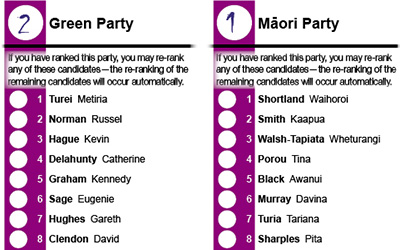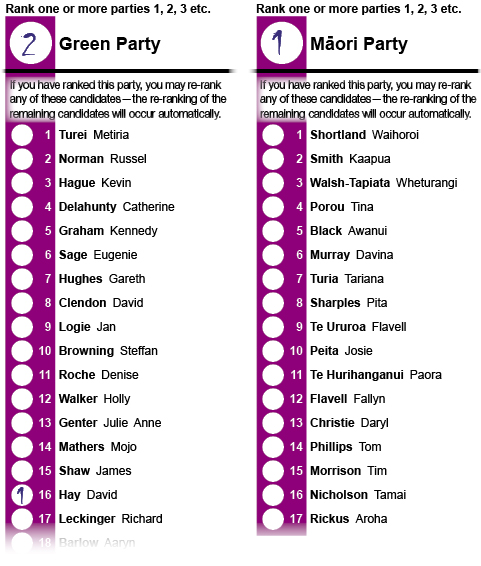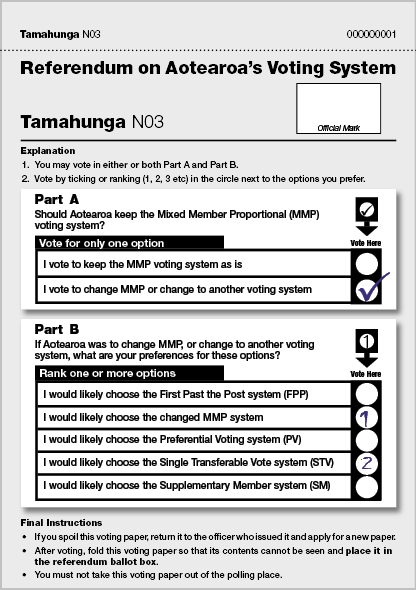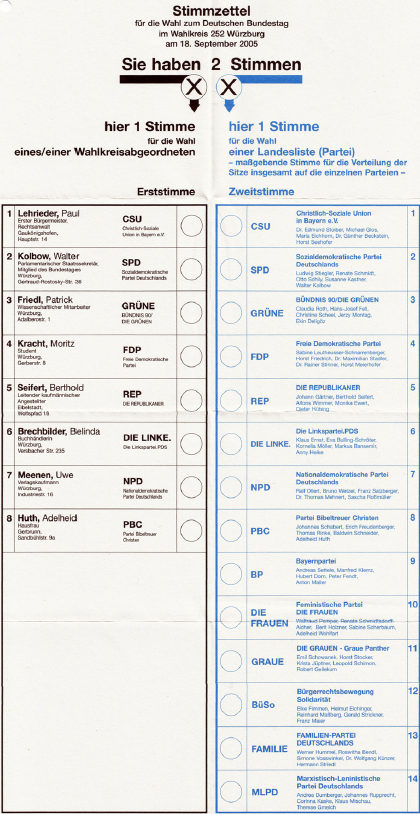Tune-up will leave MMP better loved than understood


Taming the Lists: ‘Below the line’ voting need not be unwieldy. Because most voters will be happy to accept their preferred party’s default rankings, or will only wish to promote or demote the odd candidate, democratising the party lists is imminently practicable, and would be intuitive in use. Party ballot mock-up Mahurangi Magazine
At 74.21%, Aotearoa hasn’t seen lower turnout percentages, consistently, since 1887.
And although the 1978 turnout is recorded as 69.2%, this was a one-off aberration reflecting an under-resourced attempt to reform the electoral enrolment process—the following two turnouts were 91.4% and 93.7% respectively.
German voters turn out in similar percentages to New Zealanders. While the turnout is declining in both countries, as in most industrialised states, Aotearoa in 2011 is more than four percentage points better than Germany was in 2009. This is somewhat reassuring in respect to the concern that mixed member proportional, through being a relatively complicated electoral system, could be contributing to Aotearoa’s trend in reduced voter turnout—Germans are presumably comfortable with the complexity, having voted with the mixed member system from the first post-Nazi election onwards.
While Germans well understand that the party vote is all-important, and that party allegiance of the electorate members is generally immaterial, New Zealanders, at most, have experienced only six mixed member proportional elections, with a majority of those voting having grown up the vastly simpler first-past-the-post system. This inexperience was borne out on Saturday when many New Zealanders struggled to understand why, for example, the loss of the Minister of Social Welfare Paula Bennett’s electorate seat to Labour, in itself, didn’t reduce National’s seat tally. But New Zealanders are not greatly assisted by their mainstream media, which should be seizing every opportunity to explain the mechanics of the mixed member system. The election night seat count changed due to the special votes increasing the Green’s party vote to 11.06%, sufficient to bring in its fourteenth representative, whilst simultaneously reducing National’s back to 47.31%.
Under mixed member proportional, most electorate seats are like the ice cubes in Paula Bennett’s abandoned half-full election party cocktail: Their melting doesn’t change the level in the glass, which is determined by the party vote—which in turn was subject to that special vote evaporation of 0.68 of a percentage point. The exceptions are those electorate seats that were won by charismatic leaders of minor parties where the party vote was too small to pull in list seats to achieve proportionality—the case with Act, Mana, Māori and United First. With the resources they have at their disposal, the mainstream media, and indeed the electoral commission, should be taking every opportunity to illustrate these outcomes with graphics.
It is probable that an additional reason for the record low turnout was that it was combined with a fundamentally flawed referendum on the mixed member proportional system. Thankfully for the future of their democracy, three quarters of enrolled New Zealanders voted, by a margin of 15.11 percentage points, to retain the mixed member system. However, not only would the percentage participating have probably been higher, the margin in favour of retaining and improving mixed member proportional would certainly have been much higher, had the referendum been competently designed. Inexcusably, on 26 November, New Zealanders were presented with a ballot paper that was at variance with choices actually on offer. In the first question, voters were asked:
Should New Zealand keep the Mixed Member Proportional (MMP) voting system?

Turnout Turnoff: Had its parliament possessed the wit to design a robust referendum, voter might turnout might not have been Aotearoa’s lowest in 124 years. Indubitably, in this configuration, the rate of informal answers to the second question would not have been 33.14%. Ballot design Mahurangi Magazine
and allowed to respond with either:
I vote to keep the MMP voting system
or
I vote to change to another voting system
However, to reflect the legislation under which the referendum was held, that first option should have read:
I vote to retain and review the MMP voting system
That only 93 fewer people participated in the referendum than voted in the election reflects the carefully shepherded process whereby voters had no dignified way to decline to accept the referendum paper along with their election ballot. What is notable, but unsurprising, is that a third of the referendum ballots were ‘informal’, in respect of the second question:
If New Zealand were to change to another voting system, which voting system would you choose?
New Zealanders’ enthusiasm for mixed member proportional is primarily because of its success in reforming the bad old ‘elective dictatorship’ of first-past-the-post. But they should have confidence that mixed member proportional is the only system that, subject to some fine-tuning, ensures a scrupulously fair result for both major and minor parties and features accountable single seat electorates.
Much mischief is made about electorate candidates ‘sneaking back into Parliament on the list.’ A failed electorate candidate is just that. For example, Paula Bennett can’t claim to be the member for Waitakere; although her party had every right to place her sufficiently high on its list to ensure she could suffer an electorate defeat and survive to be promoted to the front bench. But that is under the current implementation. A far more democratic system would allow voters, should they wish to do so, to override the list of the party they are supporting by also voting ‘below the line’, to use Australian electoral parlance.
Traditionally, lists have been the bane of proportional voting systems. A notorious example is the ‘tablecloth’ ballot paper of 1999, which led to a reform of the New South Wales upper house electoral rules. Aotearoa approached proportional voting via a very different, list-less route, and consequently can avoid the spectre of the tablecloth-sized ballots—mind, picnic blanket might have been a more apt metaphor, given that it was the Outdoor Recreation Party that engineered that 1999 aberration, in a fiendish and successful bid to gain representation for minor parties New South Wales’ upper house.
Computerised ballot systems are the obvious way to walk voters through a proportional voting system. When it came to a voter’s party preferences, the voter would first be asked which party, or parties, they wished to support. A Māori Party supporter with Green sympathies might rank the Māori Party 1 and Green Party 2. Next this voter would be asked if they wished to express their preferences for the Māori Party list. The hypothetical voter declines to do so, being both happy with party’s ranking, but also in the knowledge that, in this hypothetical 2011 election, the party vote would probably be too low to bring in any list members.

Similarly List-Less System: Aotearoa came to proportional representation via Germany, rather than Australia, thus avoiding the latter’s sometimes tablecloth-sized party lists. image Wikipedia
Next the voter is asked if they wished to express their preferences for the Green Party list. Here the hypothetical voter does choose to exercise her entitlement. Strongly approving the party’s strategy of emphasising green growth, the voter is unhappy that David Hay is too low on the list to be elected, on the indications of the pre-election polling trends. The Green list would be displayed as ranked by the exemplary transparent and democratic process that the party has long followed, and now—at least in this hypothetical scenario—all political parties are legally required to follow.
The hypothetical voter promotes David Hay to the top of his party’s list.
An imperative of a robust voting system is that votes should not be wasted. In the actual 2011 election, the 31 982 votes that the Māori Party received were wasted, because more than twice that number were needed to pick up a list seat in addition to the three electorate seats it won. Any party votes not used to elect candidates therefore should be have been transferred to those voters’ next preference. In this hypothetical 2011 election, the hypothetical Māori Party supporter with Green sympathies’ party vote goes to the Green Party and, by opting to also vote ‘below the line’, fractionally increases the chances of David Hay ranking higher than his party-imposed position at 16.
Such a system will not satisfy voters who are essentially motivated to vote against an electorate candidate. But such voter behaviour is symptomatic of deficient, pre-proportional voting electoral systems. If a voter feels sufficiently strongly about a candidate’s worthiness to be high on a particular party’s list, they could give their first party preference to that party and then proceed to lower that candidate’s ranking. Chances are, however, they are not only opposed to the particular candidate, but they are also opposed to that candidate’s party, and so would have little option but to focus on accentuating the positives within their own camp.
Including those for the Māori Party, a total of 75 492 votes were wasted the 2011 election, sufficient to elect four of the 51 list seats. This is arguably a far greater travesty than the slight disproportionality that arose from Act, Mana, Māori and United First winning more seats than their respective party vote. Such so-called overhang is small price to pay; the alternative would require minor parties to forfeit any electorate seats that gave them greater representation than they were entitled through their respective share of the party vote.
The prerequisites for a fair electoral system are simple: Votes should not be wasted and parties should receive their fair percentage of representation. In the pursuit of that fair electoral system, however, there is no escaping complexity. But nor should that complexity be on the surface to confound voters, election after election. A well-designed system should be intuitive to use and leave voters confident that the preferences they express will contribute to the electoral outcome.
It is better that mixed member proportional is much-loved because of the fair result it produces, than because its arcane machinations are well-understood.

At last an explanation of the present MMP electoral voting system, and a solution! The solution, which I hope the editor forwards to the Electoral Commission, answers so many of the questions of fairness, and the opportunity to list the list MPs, is an opportunity that lots of voters want. Kia ora